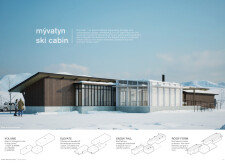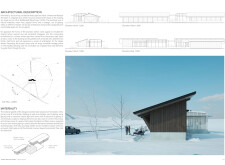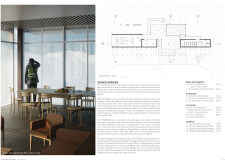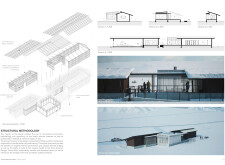5 key facts about this project
Mývatn Ski Cabin is located in the Mývatn region of Iceland, an area known for its dramatic landscapes and rich folklore. Designed primarily as a retreat for winter sports enthusiasts, the cabin integrates modern architectural practices with local cultural elements, reflecting the ecological context and aesthetic qualities of the surrounding environment.
Spatial Organization
The cabin comprises three interlinked volumes, each serving a specific purpose. The REST & WARM zone features a communal area with expansive glass facades, allowing ample natural light and offering views of the surrounding slopes. This space is designed to enhance user comfort and foster interaction with the environment. The CHANGING area provides essential facilities for skiers, including privacy-focused changing rooms to ensure thermal comfort.
The SERVICE volume houses practical amenities such as equipment storage, strategically positioned for convenience and efficiency with ski operations. This thoughtful spatial arrangement aims to maximize views and usability while maintaining a direct connection to the natural landscape.
Material Selection and Performance
The Mývatn Ski Cabin employs a diverse material palette that prioritizes local resources and sustainability. Timber cladding and structural elements establish a warm aesthetic tied to traditional Icelandic building practices, while extensive use of glass emphasizes natural light and visual integration with the environment. Concrete bases provide stability against the region's challenging weather conditions, and Cross-Laminated Timber (CLT) serves as a sustainable structural solution, aiding in carbon footprint reduction.
The selection of materials enhances the building's visual appeal and its thermal performance, contributing to energy efficiency in a demanding climate. The exterior design features a series of skillion roofs aligned with the sloping terrain, effectively managing snow accumulation and ensuring operability during the winter months. A double timber stud wall system enhances thermal insulation and durability, demonstrating a careful focus on structural integrity for the local environment.





















































